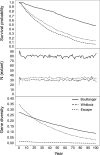Using PVA and captive breeding to balance trade-offs in the rescue of the island dibbler onto a new island ark
- PMID: 35831431
- PMCID: PMC9279492
- DOI: 10.1038/s41598-022-14150-9
Using PVA and captive breeding to balance trade-offs in the rescue of the island dibbler onto a new island ark
Abstract
In the face of the current global extinction crisis, it is critical we give conservation management strategies the best chance of success. Australia is not exempt from global trends with currently the world's greatest mammal extinction rate (~ 1 per 8 years). Many more are threatened including the dibbler (Parantechinus apicalis) whose remnant range has been restricted to Western Australia at just one mainland site and two small offshore islands-Whitlock Island (5 ha) and Boullanger Island (35 ha). Here, we used 14 microsatellite markers to quantify genetic variation in the remaining island populations from 2013 to 2018 and incorporated these data into population viability analysis (PVA) models, used to assess factors important to dibbler survival and to provide guidance for translocations. Remnant population genetic diversity was low (< 0.3), and populations were highly divergent from each other (pairwise FSTs 0.29-0.52). Comparison of empirical data to an earlier study is consistent with recent declines in genetic diversity and models projected increasing extinction risk and declining genetic variation in the next century. Optimal translocation scenarios recommend 80 founders for new dibbler populations-provided by captive breeding-and determined the proportion of founders from parental populations to maximise genetic diversity and minimise harvesting impact. The goal of our approach is long-term survival of genetically diverse, self-sustaining populations and our methods are transferable. We consider mixing island with mainland dibblers to reinforce genetic variation.
© 2022. The Author(s).
Conflict of interest statement
The authors declare no competing interests.
Figures



References
-
- Burbidge AA, Abbott I. Mammals on Western Australian islands: occurrence and preliminary analysis. Aust. J. Zool. 2017;65:183–195. doi: 10.1071/zo17046. - DOI
-
- Fischer J, Lindenmayer DB. An assessment of the published results of animal relocations. Biol. Conserv. 2000;96:1–11. doi: 10.1016/S0006-3207(00)00048-3. - DOI
-
- Legge S, et al. Havens for threatened Australian mammals: the contributions of fenced areas and offshore islands to the protection of mammal species susceptible to introduced predators. Wildl. Res. 2018;45:627–644. doi: 10.1071/wr17172. - DOI
-
- Morris K, et al. Forty years of fauna translocations in Western Australia: lessons learned. In: Armstrong DP, Hayward M, Moro D, Seddon PJ, et al., editors. Advances in Reintroduction Biology of Australian and New Zealand Fauna. CSIRO Publishing; 2015.
-
- Seddon PJ, Moro D, Mitchell NJ, Chauvenet A, Mawson P. Proactive conservation or planned invasion? Past, current and future use of assisted colonisation. In: Armstrong DP, Hayward M, Moro D, Seddon PJ, editors. Advances in Reintroduction Biology of Australian and New Zealand Fauna. CSIRO Publishing; 2015.
Publication types
MeSH terms
LinkOut - more resources
Full Text Sources
Research Materials
Miscellaneous

